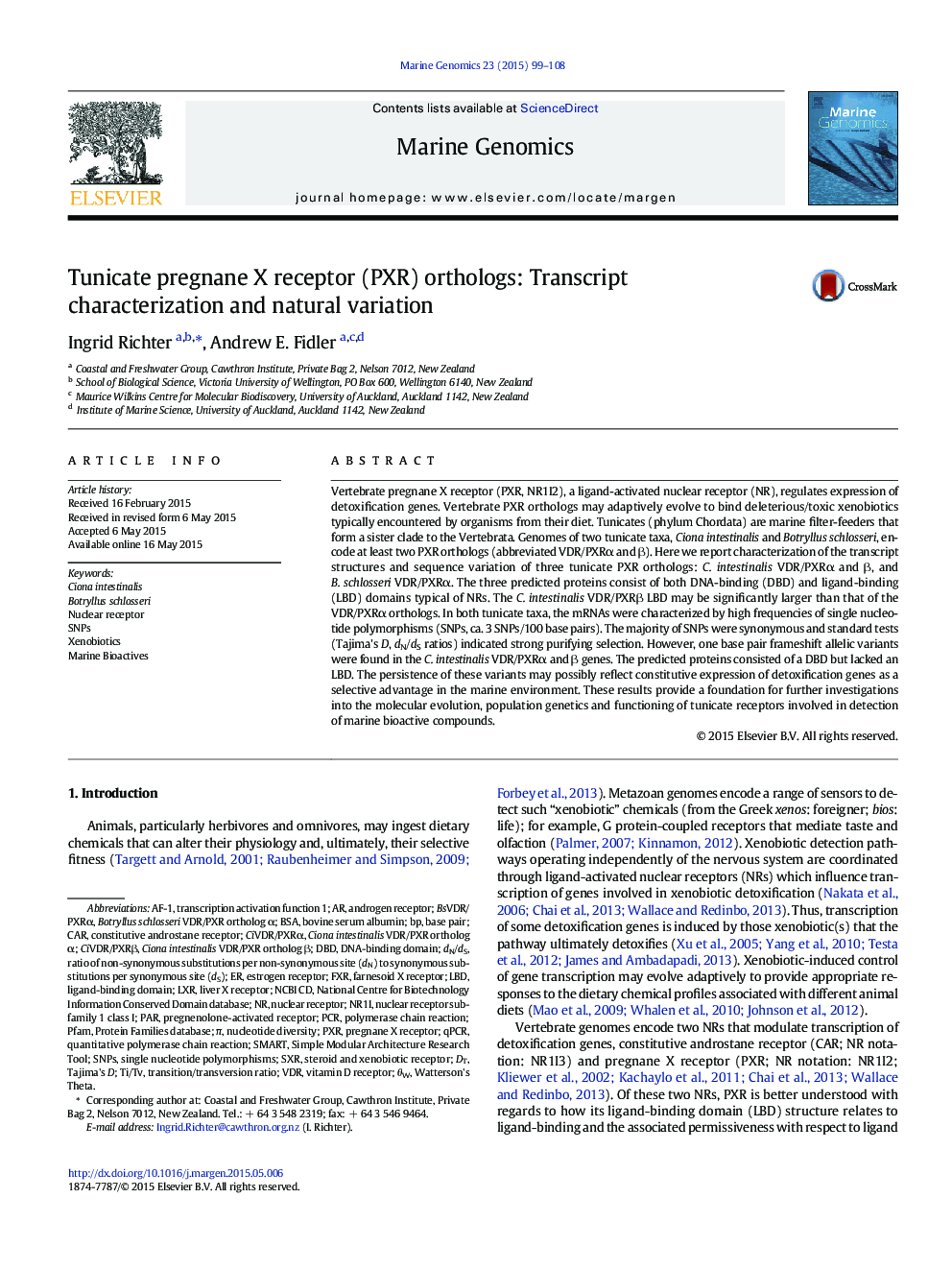| کد مقاله | کد نشریه | سال انتشار | مقاله انگلیسی | نسخه تمام متن |
|---|---|---|---|---|
| 8388431 | 1543926 | 2015 | 10 صفحه PDF | دانلود رایگان |
عنوان انگلیسی مقاله ISI
Tunicate pregnane X receptor (PXR) orthologs: Transcript characterization and natural variation
دانلود مقاله + سفارش ترجمه
دانلود مقاله ISI انگلیسی
رایگان برای ایرانیان
کلمات کلیدی
Tajima's DPfamFXRCiona intestinalisSteroid and xenobiotic receptorVDRAF-1SNPsBotryllus schlosseriLBDDBDqPCRLXRSXRPXRBSA - BSAdN/dS - DN / DSfarnesoid X receptor - Farnesoid X گیرندهbovine serum albumin - آلبومین سرم گاوSimple modular architecture research tool - ابزار تحقیق معماری مدولار سادهXenobiotics - بیگانه زیست، زنوبیوتیکNucleotide diversity - تنوع نوکلئوتیدPar - توسطbase pair - جفت پایهDNA-Binding Domain - دامنه اتصال DNAligand-binding domain - دامنه اتصال لیگاندCAR - ماشینSMART - هوشمندانهpolymerase chain reaction - واکنش زنجیره ای پلیمرازquantitative polymerase chain reaction - واکنش زنجیره ای پلیمراز کمیPCR - واکنش زنجیرهٔ پلیمرازSingle nucleotide polymorphisms - پلیمورفیسم تک نوکلئوتیدیliver X receptor - کبد X گیرندهconstitutive androstane receptor - گیرنده آندروستان پایدارAndrogen Receptor - گیرنده آندروژنیEstrogen receptor - گیرنده استروژنVitamin D receptor - گیرنده ویتامین DPregnane X receptor - گیرنده پیش گران XNuclear receptor - گیرنده هستهای، گیرندههای هستهای
موضوعات مرتبط
مهندسی و علوم پایه
علوم زمین و سیارات
علوم زمین و سیاره ای (عمومی)
پیش نمایش صفحه اول مقاله

چکیده انگلیسی
Vertebrate pregnane X receptor (PXR, NR1I2), a ligand-activated nuclear receptor (NR), regulates expression of detoxification genes. Vertebrate PXR orthologs may adaptively evolve to bind deleterious/toxic xenobiotics typically encountered by organisms from their diet. Tunicates (phylum Chordata) are marine filter-feeders that form a sister clade to the Vertebrata. Genomes of two tunicate taxa, Ciona intestinalis and Botryllus schlosseri, encode at least two PXR orthologs (abbreviated VDR/PXRα and β). Here we report characterization of the transcript structures and sequence variation of three tunicate PXR orthologs: C. intestinalis VDR/PXRα and β, and B. schlosseri VDR/PXRα. The three predicted proteins consist of both DNA-binding (DBD) and ligand-binding (LBD) domains typical of NRs. The C. intestinalis VDR/PXRβ LBD may be significantly larger than that of the VDR/PXRα orthologs. In both tunicate taxa, the mRNAs were characterized by high frequencies of single nucleotide polymorphisms (SNPs, ca. 3 SNPs/100 base pairs). The majority of SNPs were synonymous and standard tests (Tajima's D, dN/dS ratios) indicated strong purifying selection. However, one base pair frameshift allelic variants were found in the C. intestinalis VDR/PXRα and β genes. The predicted proteins consisted of a DBD but lacked an LBD. The persistence of these variants may possibly reflect constitutive expression of detoxification genes as a selective advantage in the marine environment. These results provide a foundation for further investigations into the molecular evolution, population genetics and functioning of tunicate receptors involved in detection of marine bioactive compounds.
ناشر
Database: Elsevier - ScienceDirect (ساینس دایرکت)
Journal: Marine Genomics - Volume 23, October 2015, Pages 99-108
Journal: Marine Genomics - Volume 23, October 2015, Pages 99-108
نویسندگان
Ingrid Richter, Andrew E. Fidler,